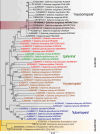Expanding geographic distribution knowledge of Galerinamarginata (Batsch) Kühner (Agaricales, Hymenogastraceae) with a novel Antarctic record
- PMID: 38948134
- PMCID: PMC11214013
- DOI: 10.3897/BDJ.12.e125727
Expanding geographic distribution knowledge of Galerinamarginata (Batsch) Kühner (Agaricales, Hymenogastraceae) with a novel Antarctic record
Abstract
Background: The investigation of Agaricales diversity in the Antarctica is limited, with only seven genera reported for the region. Galerina stands out as the genus with the highest species diversity, including 12 species in Antarctica. This research reports the presence of G.marginata in the region, providing the first complete morphological description for the specimen developing in Antarctica. Sampling was conducted during the Austral summer of 2022/2023 as part of the XLI Brazilian Antarctic Operation in Point Smellie, Byers Peninsula, Livingston Island, South Shetland Archipelago, Antarctica. Phylogenetic relationships reconstructed by Maximum Likelihood demonstrate that G.marginata forms a monophyletic clade with over 60% bootstrap support in most branches. The isolate in this study was found to be internal to the main cluster. Evolutionary reconstructions using the Maximum Likelihood method indicate that the branches correspond to the Antarctic isolate being an internal clade within the marginata group. Recording fungal populations in polar regions offers information about their adaptation and survival in inhospitable environments. Understanding the species' distribution in Antarctica encourages future investigations into its ecology and interactions with other organisms. Here, data are presented to establish an initial foundation for monitoring the G.marginata population in Antarctica and assessing the potential impacts of climate change on its development and survival in the forthcoming years.
New information: We report the third occurrence of Galerinamarginata (Batsch) Kühner in Antarctica and provide, for the first time, a comprehensive morphological description of an individual of the species for the Antarctic continent, accompanied by phylogenetic analyses and comprehensive discussions regarding its diversity and global distribution.
Fernando Augusto Bertazzo-Silva, Jair Putzke, Cassiane Furlan-Lopes, Maricia Fantinel D'ávila, Alice Lemos Costa, Evelise Leis Carvalho, Ana Flavia Zorzi, Carlos Ernesto Gonçalves Reynaud Schaefer.
Figures




Similar articles
-
Distribution of the genus Boeckella (Crustacea, Copepoda, Calanoida, Centropagidae) at high latitudes in South America and the main Antarctic biogeographic regions.Zookeys. 2019 Jun 10;854:1-15. doi: 10.3897/zookeys.854.29614. eCollection 2019. Zookeys. 2019. PMID: 31231155 Free PMC article.
-
Isolation of Campylobacter spp. from Three Species of Antarctic Penguins in Different Geographic Locations.Ecohealth. 2017 Mar;14(1):78-87. doi: 10.1007/s10393-016-1203-z. Epub 2017 Jan 13. Ecohealth. 2017. PMID: 28091764
-
Pellets of Stercorarius spp. (skua) as plant dispersers in the Antarctic Peninsula.An Acad Bras Cienc. 2022 Apr 29;94(suppl 1):e20210436. doi: 10.1590/0001-3765202220210436. eCollection 2022. An Acad Bras Cienc. 2022. PMID: 35508015
-
Trace metals in Antarctica related to climate change and increasing human impact.Rev Environ Contam Toxicol. 2000;166:129-73. Rev Environ Contam Toxicol. 2000. PMID: 10868078 Review.
-
Overview of the chemical ecology of benthic marine invertebrates along the western Antarctic peninsula.Integr Comp Biol. 2010 Dec;50(6):967-80. doi: 10.1093/icb/icq035. Epub 2010 May 11. Integr Comp Biol. 2010. PMID: 21558253 Review.
References
-
- Arenz B. E., Blanchette R. A., Farrell R. L. In: Antarctic terrestrial microbiology. Cowan D. A., editor. Vol. 1. Springer; Berlin: 2014. Fungal diversity in Antarctic soils.328. - DOI
-
- Colesie C., Walshaw C. V., Sancho L. G., Davey M. P., Gray A. Antarctica's vegetation in a changing climate. Wiley Interdisciplinary Reviews: Climate Change. 2023;14(1) doi: 10.1002/wcc.810. - DOI
LinkOut - more resources
Full Text Sources
